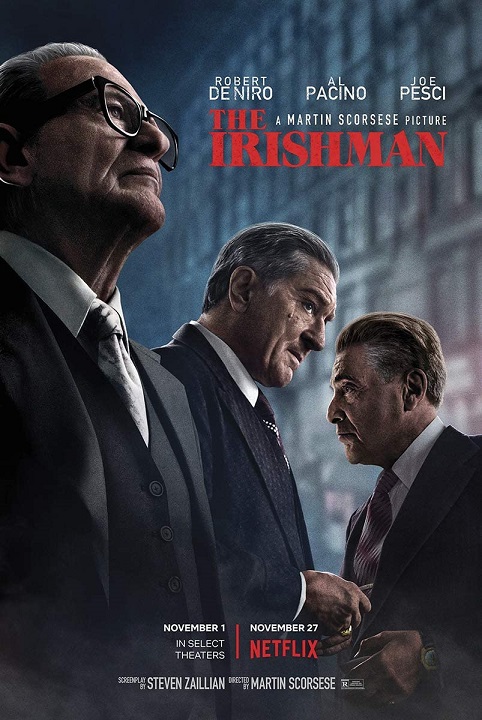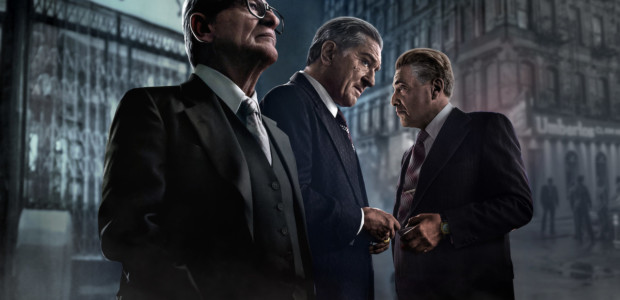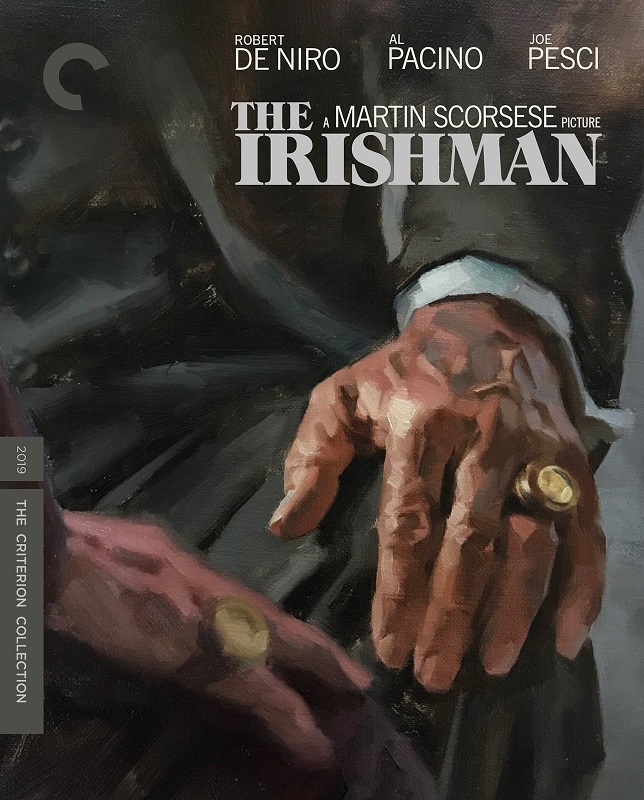“I heard you paint houses.”
“Yes, I do. I also do my own carpentry.”
A friend of mine once said that Martin Scorsese makes the same movie over and over, and I had to do everything in my power to avoid picking up a nice-looking pen off a bar and kick-stabbing him in the throat until he was a bloody mess on the ground. (I’m kidding.) (Or am I?) In a really superficial way, one could believe this was a sound observation: it’s not just because the most well-known portion of Scorsese’s filmography has taken place in the world of the Italian mafia (though relegated to only four films, including THE IRISHMAN), with a single detour into the world of Irish crime in THE DEPARTED, but also because Scorsese’s own style and techniques carry over from film to film, giving them an almost brand-like feeling. There’s the first-person narration, the “crime is awesome” montages, the Rolling Stones soundtrack, the gorgeous spot-lighting, the frenzied smash-cut editing, and an ensemble of familiar faces like Robert De Niro, Joe Pesci, Harvey Keitel, the somewhat obscure Frank Vincent, and pretty much the entire supporting cast of THE SOPRANOS. “I liked it the first time I saw it… when it was called GOODFELLAS,” a mid-90s SNL oddity known as David Spade once said about CASINO. Gestating since at least 2008, THE IRISHMAN was predictably lobbed from the start with the same kind of shallow proclamations that Scorsese and De Niro were going to make yet another version of GOODFELLAS, even before a single frame had been shot. Once the film finally made its long-awaited debut on Netflix, twelve years after it was first announced, the camp was still split on what kind of film THE IRISHMAN was vying to be. Was it just another GOODFELLAS riff, or something decidedly different?

In case you haven’t deduced it for yourself during one of my typically elongated lead-ins, THE IRISHMAN is, indeed, something decidedly different. Is it about the mafia? Yes, it is. Does it involve a fair number of GOODFELLAS et al. cast members? Yes, it does. But where GOODFELLAS was a SCARFACE-ish allegory about opulence, power, and the eventual fall from grace, THE IRISHMAN is an UNFORGIVEN-like examination of a misspent life immersed in dirty tasks for dirty people at the expense of one man’s family. That the film is headlined by an aging De Niro wasn’t just the result of the film being in pre-production for a very, very long time, but it’s also the point of THE IRISHMAN entirely. It’s about sin, regret, mortality, and legacy. And yes, De Niro, as one tends to do, has aged. For lack of a more respectful word, De Niro is now an old man. His elderliness has crept into his take on Frank Sheeran that both benefits and handicaps his performance, guiding him in his role of a soft-spoken, somewhat slowwitted boob eager to please his masters like a loyal dog, but which is also occasionally at odds with the visual technology being employed to shave decades off his real age. In a way, De Niro’s appearance and performance sum up the experience of THE IRISHMAN as a whole – still engaging, still artfully made by one of cinema’s remaining old-school masters, but maybe, perhaps, a couple decades too late.
Based on prosecutor Charles Brandt’s “non-fiction” book I Heard You Paint Houses (I say “non-fiction” because it was based entirely on Sheeran’s version of events, which many have claimed to be dubious), THE IRISHMAN is a sprawling epic where genuine history and possible artifice intermingle in ways that, regardless of the film’s ultimate dance with reality, is still a compelling story. THE IRISHMAN weaves a complex narrative of many characters, many conflicts, and many intersecting timelines. With a running time of three and a half hours, that’s not surprising. What is surprising is how quickly those three-and-a-half hours go by. Surrounding the main cast of De Niro’s hired hitman Frank Sheeran, Joe Pesci’s mob boss Russell Bufalino, and Al Pacino’s Jimmy Hoffa is an extensive ensemble cast who bring to life many of Philadelphia’s crime figures, including infamous mob boss Angelo Bruno (Harvey Keitel), Felix “Skinny Razor” DiTullio (Bobby Cannavale, sporting a “rescinding” hairline), and an unexpectedly excellent Ray Romano as attorney Bill Bufalino. (In a weird bit of my family’s history, THE IRISHMAN makes brief mention of crime figure Frank Sindone, who helped plan the hit on Bruno and was later found dead in an alley with three bullets in his head. My Philadelphia-born father once unknowingly shared a car ride with Sindone and others from the neighborhood and later described him as “pretty fuckin’ intense.” My father also had a cousin [for whom things didn’t end well] who worked at the Latin Casino, which is featured during Sheeran’s “Appreciation Night” after he becomes President of the Teamsters’ Local Union 326. I keep telling him he needs to write his own book about 1970s Philly because he’s seen some shit.)
In a way, even though any film should consider a comparison to GOODFELLAS extremely flattering, THE IRISHMAN works much better as its own beast. The gliding cameras, the eclectic oldies soundtrack, the voiceover: sure, those things are all present and accounted for – but THE IRISHMAN is measured, calm, patient, and mature. It’s a film that stands on its own, of course, but it’s also an acknowledgement of the long and very successful careers of those who made it. It’s Scorsese touching base with audiences and gently reminding them that his on-screen mafia tales are what’s attracted the most eyes, garnered his best critical notices, and punctured pop culture in ways that many of his other films didn’t. And let’s face it: Scorsese wouldn’t have gone back to this same well so many times if he, himself, wasn’t so fascinated with a life of crime. What began on a small scale in something like 1973’s MEAN STREETS, made with a guerilla-style, low-budget scrappiness, has culminated forty-five years later with THE IRISHMAN, a two hundred-million-dollar epic that likely hit more eyeballs in its first day on Netflix than did his 2016 Jesuit priest drama SILENCE during its entire theatrical run. Indeed, Scorsese trots out many of his trademarks, though the occasionally abrupt editing by longtime collaborator Thelma Schoonmaker is much more restrained, in keeping with THE IRISHMAN’s slower pace. Though Scorsese still falls back on voice-over from a few characters, now they directly address the camera like they’re confessing their sins to us, the audience. As for his new bag of tricks? Yes, the controversial de-aging technology, which landed with audiences in extremely polarizing ways. “It looked great!” versus “It looked terrible!” flooded reviews and talk-backs. Snotty backseat drivers uploaded their own “deep fake” videos to YouTube to show how it could’ve been done cheaper and with better results. But here’s the thing: the de-aging technology itself actually looks fantastic, removing the deep creases and weathered appearances of our charming older men. The problem, however, is that those brand-new youthful faces are then pasted over their still-old dumpy bodies, and the additional decision to have De Niro wear blue contact lenses to “look Irish” (even though he played an Irishman in GOODFELLAS and wore no such thing) only does a disservice to the millions of dollars spent on those faces. Despite what the actors and choreographers tried, old men can only move like old men, and when it comes time for De Niro to knock down and kick-stomp the local grocery store owner, he kicks like an old man, and it’s hard not to notice.
Frank “The Irishman” Sheeran is an atypical performance for the De Niro we’ve come to anticipate from a Scorsese film, but perfectly appropriate and in line with not only the real Frank Sheeran, but the work De Niro has been doing as an actor since the early 2000s. Throughout his collaborations with Scorsese, or during the “nod” roles he’d play after the fact that painted him as a mob boss of sorts, De Niro was always in a position where he wielded power and influence (or in the case of Brian De Palma’s THE UNTOUCHABLES, baseball bats). Audiences have spent the last several decades affiliating themselves with De Niro the boss, from GOODFELLAS’ Jimmy Conway to CASINO’s Sam Rothstein. This time, however, he’s the bag man, the hired gun, the administrative assistant who just so happens to steal and kill. Hell, he’s not even comfortable pulling the car over unless someone else says it’s okay. “I was a working guy,” Sheeran says early on before he made his way into the crime world, but even after that, he was still a working guy – it’s just that the things he did are what changed. Sheeran, as presented, is a pathetic figure, only finding worth in the eyes of the crime figures who want him around, while barely making time for his own family. One gets the impression that De Niro, for the first time in his life, is actually wanted around, and it renders him a purposely toothless presence, putting him into certain situations to perform acts he doesn’t have the guts to refuse. When Sheeran retreats to an empty bedroom to make a private phone call he’s been dreading, it’s the most pathetic De Niro has made one of his characters look in his fifty years of acting – even more than his famous scene in TAXI DRIVER where he’s being consistently rebuffed over the phone by Cybil Shephard’s Betsy, whom, after a disastrous date, wants nothing to do with him. “What kind of man makes a phone call like that?” Sheeran later muses during one of the film’s final scenes. De Niro, the boss who stomped on Billy Bats’ skull, who tore through the pimp underworld to save a young girl, who refused to be knocked down by Sugar Ray Robinson, has become a spineless, subservient slave, and he was the one who let it happen.
Sharing the screen with De Niro for the first time since 1995’s CASINO is Joe Pesci, who makes a welcome return to Scorsese and co.’s world, his last high-profile project being his good friend De Niro’s 2006 directorial project, THE GOOD SHEPHERD. Let me just say this: he was incredibly missed, as he offers up the film’s best performance. Gone are the days of the volatile Tommy DeVito and Nicky Santoro. Though his Russell Bufalino is “the boss,” he exacts that title almost manipulatively in soft-spoken but firm tones. He never, once, goes big, mirroring De Niro’s more neutered approach, and it’s quite honestly one of the best performances in his career. But don’t worry! Al Pacino is definitely ready to take on everyone’s yelling for them. Speaking of, though Pacino offers a fine performance as Jimmy Hoffa, he seems to be playing just another version of Pacino instead of the real man; if we must compare, it doesn’t come close to Jack Nicholson’s take from 1992’s HOFFA, directed by Danny Devito.
Though THE IRISHMAN is about ugly things, it doesn’t glamourize them in the same ways as GOODFELLAS and CASINO. In some respects, THE IRISHMAN feels like the thematic third part of a trilogy that includes those two titles. It’s the end result of long lives spent creating and depicting stories of crime, but also of the real lives that inspired those stories, the toll taken from living on the wrong side of the law, and that no matter what one’s calling in life may be, eventually, everything comes to an end. And if, at the end of your life, you’re haggling with the salesman over the price of your own coffin – when you’re the one making the arrangements for your funeral because your family won’t do it – you know that’s a life that was lived selfishly, cruelly, and deeply alone.
Coming as no surprise, Criterion’s presentation of THE IRISHMAN on Blu-ray is stunning, easily besting the streaming version on Netflix courtesy of a new 4K scan created entirely for this release (in case you’re wondering why someone would purchase a disc for a movie they can watch on Netflix right now). Though Scorsese opted not to record a commentary for his opus (he’s not recorded one since THE AVIATOR in 2004), Criterion have assembled some pretty great and thorough supplements for this release. The most substantial is “The Making of THE IRISHMAN,” which runs almost 40 minutes. Every major cast and crew member (minus Pesci) is on hand to lend a little background on the project and their experiences with it. Scorsese discusses the parallels of making a movie about old, aging men who spent their lives working together by old, aging men who spent their lives working together. Despite that, Scorsese’s level of manic energy hasn’t diminished, as one participant amusingly notes: “He moves at the speed of Marty.” Also discussed is Scorsese’s attention to detail, with Canavale remarking on the unexpectedly heavy period phones. (Fun fact! They shot scenes for THE IRISHMAN in the same diner they used for GOODFELLAS, which is now officially called…the “Goodfellas Diner.”)
The roundtable supplement, which was previously made available on Netflix, sees Scorsese sharing drinks with De Niro, Pesci, and Pacino as they discuss their histories together both professional and personal. During this, Scorsese defends his use of de-aging CGI as another form of makeup, comparing it to the physical prosthetics of old, saying that, either way, you know the actor is under there somewhere.
“Gangsters’ Requiem,” a video essay by film critic Farran Smith Nehme, is a fantastic must-watch for cinephiles or long-time fans of Scorsese’s work. Smith Nehme talks about THE IRISHMAN’s pervading sense of death, its similarities and differences to GOODFELLAS, and points out many things you may have missed during your previous viewings. (The overhead shot of Sheeran zipping up a garment bag that looks uncomfortably like a body bag blew my mind.)
The complete list of special features is as follows:
- NEW 4K DIGITAL MASTER, approved by director Martin Scorsese, with Dolby Atmos soundtrack
- Newly edited roundtable conversation among Scorsese and actors Robert DeNiro, Al Pacino, and Joe Pesci, originally recorded in 2019
- Making THE IRISHMAN, a new program featuring Scorsese; the lead actors; producers Emma Tillinger Koskoff, Jane Rosenthal, and Irwin Winkler; director of photography Rodrigo Prieto; and others from the cast and crew
- Gangsters’ Requiem, a new video essay by film critic Farran Smith Nehme about THE IRISHMAN’s synthesis of Scorsese’s singular formal style
- Anatomy of a Scene: THE IRISHMAN, a 2020 program featuring Scorsese’s analysis of the Frank Sheeran Appreciation Night scene from the film
- The Evolution of Digital De-aging, a 2019 program on the visual effects created for the film
- Excerpted interviews with Frank “The Irishman” Sheeran and Teamsters trade-union leader Jimmy Hoffa from 1999 and 1963
- Trailer and teaser
- English subtitles for the deaf and hard of hearing
- PLUS: An essay by critic Geoffrey O’Brien
As much as I loved to see the likes of De Niro, Pacino, Pesci, and Keitel sharing the screen together again, it pains me to say that THE IRISHMAN could’ve been a flawless endeavor if our primary trio of actors had been relegated to playing the last two time periods depicted in the film, while falling back on younger actors for the previous two. (Hey! Like they did in GOODFELLAS!) Having said that, THE IRISHMAN is still top-tier filmmaking for everyone involved and showcases a director who, despite his age, has no intent on slowing down.
THE IRISHMAN is now available on Blu-ray from the Criterion Collection.
Tags: Al Pacino, Albert Anastasia, Anna Paquin, Bobby Cannavale, Charles Brandt, criterion, Dascha Polanco, Domenick Lombardozzi, Don Rickles, Gary Basaraba, Gregory Manchess, Harvey Keitel, History, Jack Huston, Jerry Vale, Jesse Plemons, JFK, Jim Norton, Jimmy Hoffa, Joe Gallo, Joe Pesci, Kate Arrington, Kathrine Narducci, Marin Ireland, Martin Scorsese, Paul Ben-Victor, Ray Romano, Robbie Robertson, Robert De Niro, Robert Funaro, Robert Kennedy, Rodrigo Prieto, Sam Giancana, Sebastian Maniscalco, Stephen Graham, Steven Van Zandt, Steven Zaillian, Thelma Schoonmaker



No Comments